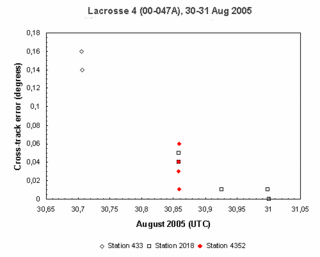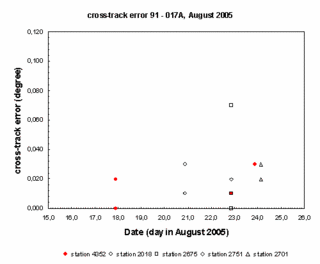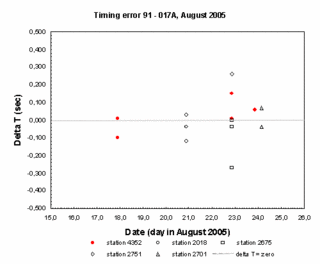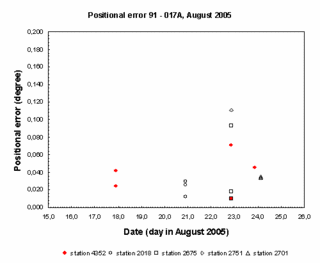I've been doing some accuracy tests lately to check
on the accuracy of my experimental photographic camera
setup, as I am always striving for improvement.
After comparing some of my datapoints with data by others
on the same satellites earlier (see earlier blog entries),
I took advantage of the current start of nice and favourable
ISS evening passes to use ISS as a test target and compare
obtained positions to an accurate ISS TLE.
I obtained 4 positions from 2 images for ISS during last
evenings 19:55 UTC pass: two (the first two) with ISS in
the zenith, two with ISS going into eclips low in the
southeast.
25544 98 067A 4352 F 20050904195525800 17 75 1900355+263390
25544 98 067A 4352 F 20050904195536500 17 75 1952060+282850
25544 98 067A 4352 F 20050904195635800 17 75 2321209+227230
25544 98 067A 4352 F 20050904195646500 17 75 2339494+210810
Using Scott Campbell's SatFit I compared them to an accurate
TLE for epoch 05247.96166413
The result is as follows:
AZ EL ASP XTRK deltaT Perr
( 1) 184.50 64.32 83.18 0.02 -0.02 0.028
( 2) 157.31 65.03 94.14 0.01 -0.02 0.027
( 3) 96.58 34.40 137.74 0.00 -0.06 0.032
( 4) 94.09 30.36 141.68 0.03 0.17 0.091
sum 0.05184
Of course I was very happy with this result. When I use
the TLE issued previous to the above one (05247.68884259),
I get:
AZ EL ASP XTRK deltaT Perr
( 1) 184.50 64.32 83.17 0.03 0.18 0.204
( 2) 157.31 65.03 94.12 0.03 0.18 0.205
( 3) 96.58 34.40 137.73 0.00 0.13 0.067
( 4) 94.09 30.36 141.66 0.03 0.37 0.171
sum 0.17140
...and the truth will be somewhere inbetween I guess.
The 4th point merits some comment, as it clearly deviates
in the series. The reason is that the 4th point was
obtained while ISS was going into eclips fast. Instead of
being the true end of the trail due to the end of the
exposure (the reference time for this point), it probably
is the point where ISS crossed the imaging threshold of the
camera while fading out. Hence it being "too late" compared
to the other points.
I've been thinking about the pittfals of my system, and
the obvious one is pointed out by point 4 in the above series.
A start- or endpoint of a trail is not reliable when it is
not marking the start or end of the exposure, but the point
where the brightness of the satellite crosses the imaging
threshold, the trail limiting magnitude of the camera. This can
happen when the sat fades in or fades out (or both) or is faint
and irregular in brightness. When that is the case, it should
translate in a first point that is apparently "too early",
and/or a second point that is apparently "too late". Whenever
such things are visible in my data compared to other datapoints,
this is probably the reason.
But for a bright sat not near eclips, this ISS test again
suggests the digital camera system performs quite well.
So far this little, encouraging test. Hereby, I also want to
thank Scott Campbell for making available his software.








